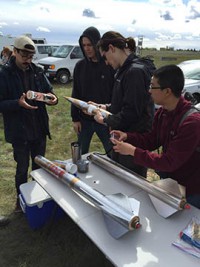North Seattle College’s rocketry program takes flight

Last spring, North Seattle College Instructor Tracy Furutani and his students began building two high-powered rockets. Their goal was to successfully launch their rockets and recover the telemetry data obtained by the rockets during flight. The article below is taken from the group’s final report, written by student Amber Hackney.
The major outcomes of the rocketry project were simple, but certainly not easy to do: to successfully build and launch two high-powered rockets, involving a total of nineteen students. Ultimately, we would be successful, thanks to a great many people.
Washington NASA Space Grant Scholars Leah Lackey, Cody Brewer, Matthew Veloz, Bart Olson and Dylan Faherty provided essential guidance for the project, steering the teams with a steady hand. The teams were comprised of the students from the Astronomy 102 class (Space and Space Travel).
The project was done in two stages: build and launch. Each stage had a different team.
The build team started it all, constructing the rocket out of a series of tubes, rings, and fins — all held together with a good amount of epoxy. The good thing about using epoxy was that it could withstand quite a bit of pressure and would hold the rocket together very well. The downside was that it took twenty-four hours to set.
The time needed for the epoxy to dry completely created a challenge when it came to placing the fins, an essential part of what would make the rocket fly effectively. To keep the fins in place while the epoxy dried, the team created a cardboard template with notches cut in. This would fit snugly over the nose of the rocket and about halfway down the fins, keeping them from shifting.
They also faced a challenge in keeping the motortube in place within the rocket stable while the epoxy dried. To do so, they inserted a cardboard ring to keep it snug. However, when they returned the next day to pull it out, they were initially unable to do so. They discovered that the epoxy from the fin had dripped onto the ring — something that happened because of how far back the ring was. In the end, the team was able to extract it by drilling screws into the ring and yanking it out.
After that, it was simply a matter of adding the parachute and painting it so the rocket would be recognizable during launch, which would be the real test of how well the team had built the rocket.

Launching a high-powered rocket is not so simple as going into someone’s backyard and flinging it in the air. Instead, the launch teams travelled to Mansfield, Washington, to join teams from three others schools that were launching their own rockets. Why Mansfield? The reasons were twofold: safety and geography. Seattle is not the flattest of areas, and it’s significantly more populated than Mansfield.
Ultimately, the launch of both rockets was a success, though there were some issues partway in. Cloud cover was a critical issue. Because the rockets would be launched to heights of around 1,500 feet, launch would not be safe unless they could see the skies so the team had to wait at times for the clouds to disperse or move away. Initially, the first rocket would not launch due to a faulty igniter. Once it was replaced, the rocket launched as planned.
Before placing the rocket on the launch pad, the team had to insert the parachute and black powder. This would cause the nose to pop off and the parachute to deploy once the available fuel had run out. It was particularly important to do this correctly both for safety, and because without the slow descent, the payload inside the rocket would be damaged. This payload contained equipment for collecting information during the flight, including altitude, acceleration, launch and chute opening times, GPS data, and temperature.
Overall, the team collected information that was accurate and useful, though factors such as weather and in some cases design of the rocket may have skewed some of the data, such as temperature readings.
Over Memorial Day weekend, the North Seattle College team return to the Mansfield launch to launch a second pair of rockets with changes in payload and in motor size. They plan to compare and analyze the data from both launch days. All six participants in the second launch day also earned their Level 1 certification from the National Association of Rocketry. To see more photos and video, visit the Mansfield 2015 album on the WSGC Facebook page.
 Amber Hackney graduated from North Seattle College in June. This fall, she will begin work on her bachelor’s degree in accounting at Central Washington University’s Lynnwood campus.
Amber Hackney graduated from North Seattle College in June. This fall, she will begin work on her bachelor’s degree in accounting at Central Washington University’s Lynnwood campus.
